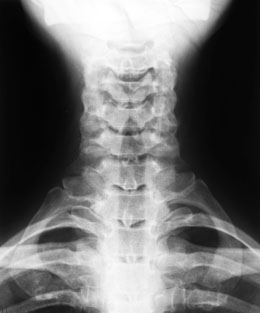While a C-shaped curve in the cervical spine is normal, problems arise when the curve becomes deep or begins to straighten up. Abnormal curvature of the cervical spine or aberrations from the normal cervical lordosis can be caused due to several reasons ranging from an injury, incorrect posture to a congenital defect called achondroplasia.

The cervical spine is C-shaped, with the C pointing towards the back of the neck. This curve is medically referred to as cervical lordosis. This curvature helps to stabilize both the head and spine and maintains balance. But sometimes, this curve may become deeper than the normal curvature. The abnormal inward curvature of the neck area can make the head appear slightly pushed forward than its normal position.
What Causes Abnormal Curvature?
Variations in the curvature of the cervical spine can be caused due to various reasons. Some of the common causes are:
- Most of the cases can be attributed to not maintaining correct posture
- Injury or trauma to the neck region
- Osteoporosis, which is characterized by the loss of mineral density of the bones can also bring about a change in the normal curvature of the cervical spine.
- Obesity
- Achondroplasia, which is an inherited skeletal disorder
Symptoms
» The person having the condition has been observed to remain unaware of any change in the curvature of his or her neck for several years. The curvature of the cervical spine changes slowly.
» When the change is significant, then one can observe the head to look like as if it has been pushed forward, or is lying slightly below its normal position.
» It is usually not accompanied by pain. However, a small number of individuals can experience neck pain, only in severe cases. Pain can be caused by the compression of nerves in the neck region, due to changes in the curvature of the cervical spine.
Diagnosis and Treatment
The changes in the curvature of the cervical spine can be detected by physical examination of the area. However, diagnostic tests like X-rays and MRI would be required to determine the extent of change in the curvature and whether the change is associated with any neurological condition.
Generally, it does not require any medical treatment, unless it is severe in nature, causes lots of pain and discomfort and limits the range of motion. In such cases, painkillers can be required to reduce the pain associated with the condition.
Most of the cases can be managed with the help of physical therapy and posture correction. Exercises on the other hand can help to strengthen the neck muscles and correct the abnormal curvature of the neck or the cervical spine. In this regard, you can practice neck stretches and neck exercises. One such simple exercise is to bring the head and neck forward and then back. Another easy exercise is to move the neck side to side towards the shoulders.
Braces can be used to hold the spine in proper alignment and correct its curvature. Sometimes, using support pillows can also prove quite beneficial for restoring the normal curvature of the neck.
However, a few cases may require surgery. Surgery for spinal fusion is generally considered as the last resort for treating the abnormal curvature of the cervical spine. But the process can pose certain risks like loss of flexibility and elasticity of the spine, which need to be considered and properly evaluated before opting for surgery. This is the reason physicians think about surgery only when other treatment options fail to correct the curvature of the spine.
You can talk to your physician or a chiropractor about the various treatment options for cervical lordosis to know about their benefits and complications and then decide accordingly. At the same time, do not forget to maintain a correct body posture and discuss with your physician about physical therapy, chiropractic care, or safe exercises to correct neck posture and other problems associated with the spinal column.
Disclaimer:
The information provided in this article is solely for educating the reader. It is not intended to be a substitute for the advice of a medical expert.


 The cervical spine is C-shaped, with the C pointing towards the back of the neck. This curve is medically referred to as cervical lordosis. This curvature helps to stabilize both the head and spine and maintains balance. But sometimes, this curve may become deeper than the normal curvature. The abnormal inward curvature of the neck area can make the head appear slightly pushed forward than its normal position.
The cervical spine is C-shaped, with the C pointing towards the back of the neck. This curve is medically referred to as cervical lordosis. This curvature helps to stabilize both the head and spine and maintains balance. But sometimes, this curve may become deeper than the normal curvature. The abnormal inward curvature of the neck area can make the head appear slightly pushed forward than its normal position.